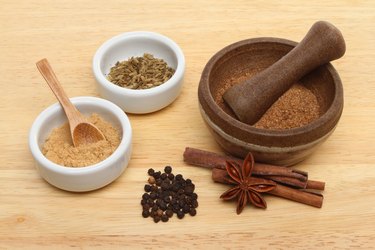
Five-spice powder, also known as Chinese five-spice powder, is a spice blend with its origins in Asian cuisine. The basic recipe includes cinnamon, cloves, fennel, star anise and Szechuan peppercorns with regional variations in proportions and even types of ingredients.
Maybe you'd like to try a unique version of your own, or maybe you simply want to make a blend using whole spices. Either way, it's not difficult to prepare a five-spice powder substitute in a home kitchen. For the best results, have on hand a good spice grinder (or a coffee grinder that has been reserved for use with spices) for this endeavor.
Video of the Day
Video of the Day
The Flavors of Five-Spice Powder
The flavor profile of this versatile compound is highly complex with sweet, salty, sour, bitter and spicy/hot elements. Some cooks would add umami (Japanese for "pleasant savory taste") to this mix. Cinnamon contributes its spicy sweetness, the anise and fennel add a pleasant licorice flavor, cloves provide an intense spiciness and the Szechuan peppercorn brings in a somewhat-bitter heat with a citrus undertone.
Note that there are two main types of cinnamon: cassia cinnamon and Ceylon cinnamon. To make things even more complicated, there are three types of cassia cinnamon: Indonesian (on the mild side), Chinese (strong and somewhat bitter) and Saigon (intensely aromatic with a floral undertone). Both the cassia and Ceylon types are marketed as rolled-up "bark." Cassia bark is tougher and thicker, while Ceylon bark is thin and quite fragile. Although cassia cinnamon is easier to find in American grocery stores, some chefs prefer Ceylon for its subtle, delicate flavor and because it crumbles easily.
Szechuan peppercorns have their own distinct flavor that is quite different from that of either ground or whole black pepper. Many cooks claim that rather than using ordinary black pepper, it would be better to just leave out the pepper altogether when making your own five-spice alternative, as some commercial blends do. Still, there are a few cooks who recommend trying out white pepper instead. Other variations on the five-spice theme incorporate such ingredients as ginger root, nutmeg, cardamom pods, turmeric, citrusy galangal or orange peel.
Five-Spice Powder Substitutes Using Preground Spices
Since even the best store-bought ground seasonings have an uncertain shelf life, it's always preferable to grind your own from small amounts of whole spices. However, it's possible to make an acceptable alternative with what you have on hand.
One approach to achieving Chinese five-spice recipe alternatives at home is to measure out small, equal amounts of the preground basic ingredients and combine them well. Have a taste of the mixture, taking your time to experience its nuances. Then, experiment with adjusting the seasonings to suit yourself and the other components of your recipe.
A more specific recipe for a Chinese five-spice substitute using preground spices is a combination of 2 tablespoons ground anise, 1 tablespoon ground fennel, 2 teaspoons ground cinnamon and a scant teaspoon of ground cloves.
Homemade Five-Spice Powder Using Whole Spices
A basic recipe using whole spices consists of grinding together 12 to 16 whole cloves, 1 tablespoon whole Szechuan peppercorn, 3 to 6 whole star anise, 1 tablespoon whole fennel seeds and 1 to 2 sticks of cinnamon broken into small pieces. You may want to grind the cinnamon and star anise separately. Again, give the concoction a taste test and adjust if you so desire.
Recipe Ideas for Five-Spice Powder
Now that you've created a batch of five-spice powder, what next? There are a great many Asian recipes calling for it, of course. For example, you can do a simple chicken and vegetable stir fry in a little oil seasoned with a few teaspoons of the spice and a pinch of salt. Another easy recipe adds zesty flavor to firm tofu cubes by tossing them in five-spice powder before frying them to delectable crispiness.
Don't stop at Asian cuisine. Mix a teaspoon of five-spice powder with a little oil and vinegar and use it as a rub for grilling steaks. Use it with pork dishes, as pork and five-spice powder are natural partners. The next time you make pumpkin pie, replace that pumpkin spice with five-spice powder instead. Yum!